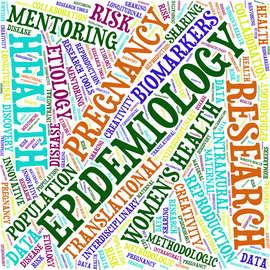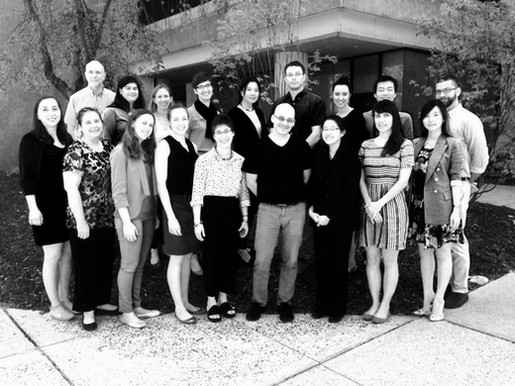 Epidemiology, the study of patterns and causes of health and disease in populations, is foundational to public health. Scientists in the NICHD's Epidemiology Branch apply epidemiologic approaches to answer questions about infertility, menstrual problems, birth defects, and other health issues.
Epidemiology, the study of patterns and causes of health and disease in populations, is foundational to public health. Scientists in the NICHD's Epidemiology Branch apply epidemiologic approaches to answer questions about infertility, menstrual problems, birth defects, and other health issues.
We recently checked in with Branch Chief Enrique Schisterman, Ph.D., to learn how his team's research is making an impact on maternal and infant health, what advice he has for aspiring epidemiologists, where his field is headed, and why it's so remarkable.
Read on to find out what he had to say.
Why is epidemiology critical to understanding the health of populations?
What are some of the big research questions the scientists in your Branch are working to answer now?
What advice do you have for those interested in pursuing fellowships or careers in epidemiology research?
What does the term "high-risk" mean within the context of epidemiology research? And what is the potential impact of high-risk projects on public health?
Why is methodological research in epidemiology important?
What do you think will be major areas of focus for the Branch—and the reproductive, perinatal, and pediatric epidemiology research fields more generally—in the next five to ten years?
What message would you like the public to know about your work, or about epidemiology research more generally?
- Why is epidemiology critical to understanding the health of populations?
Epidemiology provides the basis for describing and explaining disease occurrence in a community based on data. Population-level research allows us to identify potentially high-risk groups and begin to explain reasons behind differences in disease occurrence in order to design effective interventions. This information can have an immense impact on the population by searching for causes of health conditions, improving clinical understanding and procedures, setting policy, planning programs, and influencing individuals' health decisions. As a result, leaders in health departments consider epidemiological-related skills to be of critical importance.
Reproductive epidemiology, one of my main areas of interest, spans a broad area of research, including virtually all studies of maternal and infant health. Researchers use epidemiologic tools to study behavioral, environmental, and health care risks to reproduction for both men and women and risks to the health of their offspring. - What are some of the big research questions the scientists in your Branch are working to answer now?
The Branch is organized around key areas of research including reproductive, perinatal, pediatric, and methodologic epidemiologic research. A sampling of our many research questions includes the following:- Do parental lifestyle factors (e.g., stress, diet, intake of caffeine or alcohol) affect conception and pregnancy outcomes?
- What are the short- and long-term transgenerational impacts of common conditions in pregnancy—such as gestational diabetes, obesity and overweight, and hypertension—on offspring? What are their causes and underlying molecular mechanisms?
- Are pregnant women and infants with asthma disproportionately affected by air pollution?
- What is normal fetal growth during pregnancy? Are there any racial differences in normal fetal growth?
- Can we find low-cost interventions to improve fertility and pregnancy outcomes?
- What are the life-course determinants of cardiometabolic risks, particularly in studies of the developmental origins of health and disease? How do epigenetics play a role?
- What are the causes of birth defects, particularly genetic and biochemical risk factors for neural tube defects and other folate-related birth defects?
- A major part of the Branch's mission is to train future generations of researchers. The Branch offers training opportunities for future scientists at all levels, from high school summer internships and research projects for medical students to advanced training for physicians and Ph.D.-level investigators. What advice do you have for those interested in pursuing fellowships or careers in epidemiology research?
Epidemiology is the most amazing field to study and practice, but it is an ever-evolving field, so flexibility, hard work, and intrinsic curiosity are very useful. It is a holistic field where all of the disciplines meet, ranging from engineering and sociology to biology, medicine, and statistics. To be successful, you need to be able to work in interdisciplinary teams. Building collaborations with people in many different fields is key to success in epidemiology. The ability to ask good questions and important questions is helpful. I encourage anyone who is passionate about helping others to pursue this field.

- Branch research includes several "high-risk" research projects. What does this term mean within the context of epidemiology research? And what is the potential impact of these projects on public health?
By "high-risk," we do not mean that the research puts participants at high risk. Rather, "high-risk" research has the potential for high impact, but it may be too novel, span too diverse a range of disciplines, or be at a stage too early to fare well in the traditional peer-review process.
An example of the high-risk research that we are able to perform as intramural researchers in the Branch is the Effects of Aspirin on Gestation and Reproduction (EAGeR) Study. This is high-risk/high-reward research because aspirin is a low-cost intervention with an effect on fertility and gestation that may be small, but it has potential for a large impact on a population level.
Because of our broad reach, we have the ability to design large comprehensive studies. Many studies looking at modifiable, low-cost interventions in public health tend to have small sample sizes due to limited resources, and thus are unable to detect small effects. In our Branch, we are able to perform the sufficiently large studies necessary to investigate effects of these interventions. - Why is methodological research in epidemiology important? Tell us about some of your Branch's work in that arena.
We conduct methodologic research motivated by the many unique aspects of human reproduction and development across the lifespan. This kind of research is important because it gives us the tools to better answer the big research questions we hope to solve. The specific methodologic areas in which the Branch is conducting research include the methodologic considerations for reproductive and perinatal studies, challenges with biomarkers, causal inference, cost effective study designs, and missing data.
To go into more depth about one of our areas of methodologic research: Biomarkers make substantial contributions to our understanding of disease pathways and processes in epidemiologic research. New and emerging biomarkers are integral to this continued understanding. Biomarkers are biological measures that can be used to indicate a certain biological state, disease process, or drug response in the body. Common biomarkers include assessment of blood pressure, heart rate, and cholesterol, among others. An ideal marker should be safe and easy to measure, cost efficient to follow up, modifiable (as needed) with treatment, and consistent across gender and ethnic groups.
Biomarkers vary greatly in their relation to various causes of human disease, but also in terms of how they're measured and analyzed. We compare different biomarkers so researchers have a better idea of which ones would be best for their studies. We also inform the epidemiology community about sources and effects of measurement error, and we develop methods to properly account for those errors in statistical analyses. This helps save researchers valuable study resources. - What do you think will be major areas of focus for the Branch—and the reproductive, perinatal, and pediatric epidemiology research fields more generally—in the next 5 to 10 years?
As we imagine it, there is a growing need to increase the multidisciplinary approach to the work we do, to include innovative approaches, methods, and biomarkers.
For example, one of our studies is on the transition from gestational diabetes to type 2 diabetes. This study utilizes a novel approach of recruiting women from external [to NIH], ongoing longitudinal cohorts. This study has many benefits in that we have access to all of the previously collected data, the newly collected data, and a variety of biospecimens, including blood, toenails, and saliva, with permission to extract DNA. In addition, we are currently planning a study of the offspring born to the women in the study.
This study embodies the growing broad approach to studying diseases in populations. It will compare biospecimens from adolescents exposed to gestational diabetes or maternal obesity with those from adolescents born to pregnancies free of these complications. The study will use this comparison to assess the cardiovascular and reproductive impacts of gestational diabetes and maternal obesity.
Although this isn't the only study in which we are doing these things, this study represents many of the areas we see as important in the future: use of banked biospecimens, life-course epidemiologic approaches, omics, and imaging. - What message would you like the public to know about your work, or about epidemiology research more generally?
It is remarkable to be an epidemiologist. Finding the causes of diseases is exciting and important. The ability to discover, to have the opportunity to make real changes in people's lives, is immensely satisfying. Our Branch is fully committed to work tirelessly to find the causes of infertility, adverse pregnancy outcomes, and their long-term effects. We imagine a different world 10 years from now based on the advances we are making each day. It is wonderful to imagine that we have a very real ability to improve people's health and to improve people's lives.
More Information
For more information about the Epidemiology Branch and its role in scientific discovery, select one of the following links:
- NICHD Resources
Originally Posted: May 30, 2014

 BACK TO TOP
BACK TO TOP